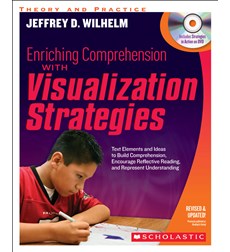How Visualization Can Improve Comprehension
Enriching Comprehension with Visualization Strategies
By Jeffrey D. Wilhelm
(Scholastic, 2012 – Learn more)

I am often skeptical when I find a book labeled “revised & updated,” but there was no reason to be with Enriching Comprehension with Visualization Strategies by Jeffrey Wilhelm. This book is truly revised & updated! Throughout the book, Wilhelm references the CCSS and connects the activities to the Common Core standards. For school leadership teams looking for a book study, Enriching Comprehension with Visualization Strategies will make an excellent choice. These 201 pages are filled with active and engaging techniques to use with both struggling and proficient readers.
As You Read
Do not skip page five: Author’s Note: Visualization Strategies and the Common Core State Standards. This may be the single most powerful page in the book.
- Be prepared to do some heavy-duty thinking and personal reflection in Chapter 3: What Does It Mean to Teach? Grounding Our Instruction in Current Research and Theory. Here the author explains how to become a learning-centered teacher.
- Park yourself at the computer for Chapter 9: Technology to Promote Visualizing, Reading, and Composing. You will want to explore the numerous websites that can be used for frontloading and/or culminating projects.
The book includes a DVD showing real teachers and real students using the visual techniques. The DVD and the classroom stories Wilhelm shares support his personal belief that “…being able to create images, story worlds, and mental models while one reads is an essential element of reading comprehension, engagement, and reflection.” (p.18) Well-crafted sidebars, found throughout the book, offer additional support and resources for teachers.
Getting started
Wilhelm suggests some easy ways to get started with visualization strategies. His practical strategies, techniques, and guidelines set students up for success.
If you have students who have difficulty visualizing at the word level, he suggests a seven-step approach that can be used with the whole class or small groups. This is an easy place to differentiate instruction since not every student will need all seven steps.
Suggested activities for word-level visualization included Writing in Sand or With String, Drawing Word Representations, Picture Flash Cards, Information Gap Activity, Vocabulary Tableaux, Vocabulary PowerPoint, Video Clips for Summarizing and Video Clips for Exploring Literary Devices.
Read-Alouds and Think-Alouds are a first step in helping students create a “story world.” Using the gradual release model, step two is Read-Alouds and Guided Imagery (I Do/You Help). Wilhelm emphasizes how important it is “to identify the visual and descriptive cues you use to see what you read.” (p. 64) Students then move to Simple Prompting (You Do/I Help). Additional activities along with a list of prompts are included for teaching students to visualize across texts.
Wilhelm shares some unique front-end strategies using visuals to activate prior knowledge and prepare children for reading. “Without frontloading, students’ comprehension never engages and can often collapse.” (p.75) Frontloading Activities might include Grab Bags, Concrete Objects/Precious Objects, Timelines, Brainstorming, and my personal favorite, Floorstorming.
When you acquire a copy of Enriching Comprehension with Visualization Strategies, write your name inside immediately. If you loan it to a colleague, you might not get it back.
Anne Anderson finally got out of the 8th grade after 24 years and 9 weeks. She spent the next 9 years sharing her expertise in literacy and writing with K-12 teachers and administrators throughout the district. She credits National Writing Project and Poetry Alive! as turning points in her growth as a teacher. She now shares her expertise nationwide as an Educational Consultant and through her website and her bi-monthly newsletter, Spotlight on Success.



































